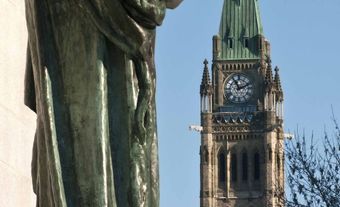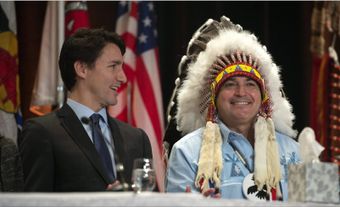Public Opinion
Public opinion is a term popularized by Jacques Necker, Louis XVI's finance minister, who wrote that public opinion influenced the behaviour of investors on the Parisian financial markets. In England Jeremy Bentham insisted that public opinion was a significant force for the social control of misrule and an important basis of democracy. In ancient societies, only among the Greeks did public opinion develop any potency. Public opinion in Europe was frequently considered the weapon of the middle class. Tocqueville, observing the role of public opinion in the US in 1835, wrote, "the majority raises formidable barriers around the liberty of opinion" and "I am not the more disposed to pass beneath a yoke because it is held out to me by the arms of a million of men."
There is no accepted definition of public opinion, although it is now part of daily vocabulary, especially that of politicians and journalists. It is generally defined as a collection of individual opinions on an issue of public interest. It does not necessarily refer to values or beliefs because opinions are more unstable and less focused. Attitude and opinion are frequently used interchangeably, but attitude is conventionally regarded as a more fundamental generalized predisposition, while opinion is a specific manifestation of underlying attitudes. When an event occurs, people form, discuss and then modify or strengthen their attitudes and public opinion is the result. Opinion is often characterized by direction, intensity, breadth and depth.
Long before systematic measures of opinion developed, it was noted that public opinion appeared to equal more than the sum of individual opinions, which led scholars observing crowd behaviour to speculate on the existence of a group mind, although the concept, at least in social science, was discarded for lack of empirical evidence. Some 20th-century social scientists postulate that the relation of individual opinions to each other results in a form of organization. Despite the lack of research on the internal structure of public opinion, some public-relations practitioners see their task as that of transforming individual attitudes into a collectivity that can exert influence. The biggest users of public-opinion research are business and industry. Newspapers, magazines, broadcasters and political parties also use polls to gather opinions.
Measuring Public Opinion
Public opinion is measured by questionnaires. The population under study is quite large, so a sampling, taken to represent the entire population, is generally used. This is the public-opinion poll, and its validity depends on the quality of the questions and of the sample taken. Efforts to measure public opinion began in the early 19th century. Some American newspapers, in an attempt to calculate the outcome of an upcoming election, asked their readers to send in their straw votes, which the paper then compiled and published. The practice became widespread during the early 20th century, especially as a result of the activities of the Literary Digest, which carried out national polls from 1910 to 1936.
The election of 1936, however, was a disaster for this kind of poll. Despite a massive sample of 2.4 million mailed-in ballots, the Digest underestimated the election of Franklin Roosevelt by 19.3%, largely because the poll ignored a significant section of the electorate. However, newcomers to the field, notably George Gallup, accurately predicted the results.
In Canada the first Gallup polls appeared in the early 1940s and now occur monthly. They are conducted by the Canadian Institute of Public Opinion. Each month the CIPO surveys the opinions of about 1000 Canadians. Gallup polls use statistical inference, estimating the attributes of an entire population from one sample. Many questions are asked and they vary from poll to poll. Gallup does ask the same questions at intervals over several years, allowing the evolution of public opinion to be traced. On the other hand, as a general rule the relatively large number of respondents unable to express an opinion clearly are presumed to have the same preferences as those that can. The presentation of results can also be misleading. A national sample used to measure voting intentions must appropriately represent demographic categories of age, sex, rural or urban residence, occupation, income, education and religious or ethnic affiliation.
Like most national-opinion surveys, Gallup polls use a combination of the quota-stratified method, which involves choosing characteristics of the population to be sampled, determination of the proportion of the population with such characteristics, and the assignment of quotas to interviewers; and the area-probability method, which involves choosing characteristics of a population to be studied, dividing the country into "areal" units, eg, counties, rural municipalities, cities, etc, arbitrarily dividing these units into area segments, selecting a certain number of dwelling units in each segment and selecting the adults (or eligible voters) to be interviewed.
The Gallup organization claims a 4% margin of error for final election results. However, this polling error, expressed as an unweighted percentage-point average (obtained by dividing total percentage-point error by the number of categories of parties), does not reflect polling competence; eg, in 1957 the average error was 3.5%, but the forecast error was 53%, or about 1 million votes. Even when, in 1962, the average polling error was only 1.5%, the disparity between the error expressed in actual votes (446 000) and the leading party's plurality of 8000 votes was very large.
Between 1945 and 1974, in 11 federal elections, the CIPO accurately predicted the percentages of votes cast for party categories in only 7 of 44 instances, and in the case of the 2 major parties the institute grossly overestimated Liberal strength in 1957 and 1965. In recent provincial elections, polling sponsored by newspapers and conducted by private organizations has increased dramatically. In many cases the polls attempt to forecast proportional vote distributions and not actual constituency outcomes. Usually a random provincial sample is consulted through telephone interviews. Some of these studies, eg, those of the Centre de recherches sur l'opinion publique, conducted during the 1970 and 1973 Québec elections, succeeded in predicting election trends only in a general manner.
Many politicians and observers have claimed that polling strongly influences the opinions it seeks to measure. It has been suggested that polls can cause voters to change their minds in order to be on the winning side, that weaker parties benefit as a result of an underdog effect, and that polls discourage voting by many who feel the results are foregone. There is no clear evidence to substantiate any of these theories, although corporate leaders, media executives, politicians and civil servants are often powerfully influenced themselves by survey results.
The literature on voting behaviour indicates that the psychology of voting is very complex and includes many determinants. Generally, citizens in democracies appear to tolerate polling errors or the use or misuse of polls by the media. After the 1970 Québec elections, evidence suggested that certain newspapers had flagrantly misrepresented pre-election survey results. In response 9 Montréal polling organizations, to forestall an outright ban on certain polling activities such as exists in BC, recommended an elaborate set of rules to control media presentation of results. Federally, the Barbeau Committee on Election Expenses recommended no poll results be published during any pre-election period. A private member's bill to the same effect was tabled in the House of Commons in 1970, but no such proposals have been passed.
In fact, Canadian political parties have used polls with increasing frequency, as have Canadian government agencies, royal commissions, task forces and other policy-oriented groups. The Liberal, Progressive Conservative and New Democratic parties all regularly commission surveys for their private use. Well-known pollsters in Canada include Allan Gregg, of Decima, Michael Adams and Martin Goldfarb. New techniques of motivational and mass-attitude analysis are deployed at national, provincial and constituency levels. These surveys are conducted not only by conventional polling specialists but by sociologists and social psychologists as well.
The newer survey methods are costly, which may affect competition between parties. The motivation behind the polling, for some politicians, also suggests a preoccupation with image projection, a tendency for party leaders to dominate in elections and consequently in decision making, and a tendency to negotiate or bargain with voters, rather than persuade them. However, researchers claim that some leaders have always sought to follow or manipulate public opinion and always will, and also point to many cases where minority viewpoints have ultimately become the prevailing opinions of the public. For obvious reasons, some politicians view published pre-election surveys with scorn, as reflected in Mr Diefenbaker's famous comment, "Every morning when I take my little dog, Happy, for a walk, I watch with great interest what he does to the poles."

 Share on Facebook
Share on Facebook Share on X
Share on X Share by Email
Share by Email Share on Google Classroom
Share on Google Classroom


